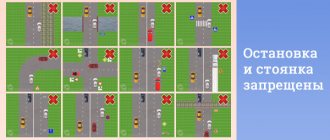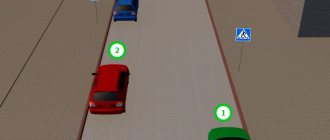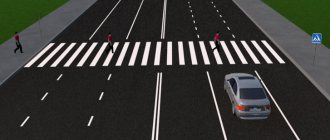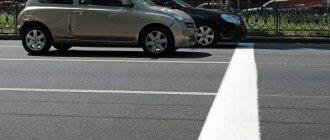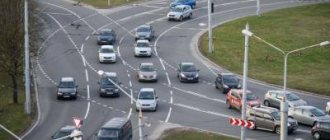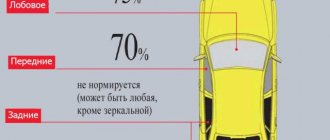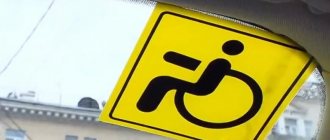What is the permissible distance to a zebra crossing for parking?
5 meters . This is regulated by paragraph 12.4 of the Road Traffic Regulations, which directly prescribes the following:
12.4. Stopping is prohibited:
- ….
- at pedestrian crossings and closer than 5 m in front of them;
That is, it is prohibited to stop not only closer than the specified distance to the pedestrian path, but also at the zebra crossing itself.
Distance to pedestrian crossing
As previously noted, parking is allowed at a distance of at least 5 meters from the crossing itself. At the same time, we note that the width of the “zebra” is not taken into account and is not taken into account in the calculation of this parameter.
There are cases when it becomes necessary to park on the left (opposite) lane of a two-way road. In this case, if there is a pedestrian crossing, position the vehicle further than 5 meters from the pedestrian crossing, or in front of it.
These rules apply to parking in front of a pedestrian crossing. Now we need to consider parking after it. And accordingly, you need to draw a conclusion that will help you understand the difference between “before” and “after”, and see the vital necessity of these rules.
Parking after a pedestrian crossing is permitted immediately after the crossing. In this case, the vehicle should not occupy part of the zebra crossing image.
The driver takes into account the location of the pedestrian crossing directly behind the intersection. In this case, according to the traffic rules, the distance from the intersection and the stopping place is taken to be at least 5 meters.
What justification is there for such rules in the difference between parking before and after the zebra crossing?
As practice shows, a car parked in the wrong place before a pedestrian crossing:
- limits visibility to other road users - pedestrians and drivers;
- First of all, it puts at risk the life of the person crossing the road.
Parking after the zebra crossing does not impair visibility at the crossing.
How to count 5 meters?
12.4 of the Rules does not indicate to what exact place these 5 meters should be counted - it only prescribes that to the object itself. Therefore, in order not to make a mistake, we need to know at what point the pedestrian crossing begins - that is, its boundaries. And the traffic rules also speak about them quite clearly in the very definition of a zebra:
Pedestrian crossing is a section of the roadway, tram tracks, marked with signs 5.19.1, 5.19.2 and (or) markings 1.14.1 and 1.14.2 and allocated for the movement of pedestrians across the road. In the absence of markings, the width of the pedestrian crossing is determined by the distance between signs 5.19.1 and 5.19.2.
5.19.1 and 5.19.2 are respectively square-shaped signs (see diagram above):
- the first one is installed to the right of the roadway and marks the beginning of the crossing, before which you can park only 5 meters away,
- the second is on the left and indicates the end of the transition.
But if there are markings, the boundary is determined by it, and when figuring out how many meters you can park before the pedestrian crossing, you need to be guided by the presence of markings:
- if there is a marking, then 5 meters in front of the zebra must be counted to the beginning of the marking line,
- if there are no markings, then count to the right sign.
The question is even more difficult: how to determine how much it will be - 5 meters? After all, not every driver carries a tape measure with him! But here, too, everything is simple - if you are not sure about the sufficient distance, then place it further away or not at all if the parking spaces in the back are occupied. Because the traffic police inspector who will issue the fine will have a tool for measuring distances.
Of course, your inability to measure exactly how many meters before the crossing will not be grounds for canceling the punishment.
How many meters before the traffic light can you park?
Parking requirements
Everyone knows that traffic lights were invented to regulate traffic at intersections. This is the most common method of automatic traffic control. Traffic lights cope well with the problem of pedestrians crossing the road. You need to park in front of the traffic light on the side of the road, at a distance of 5 meters from the pedestrian crossing. The vehicle must be parked so as not to block the passage. If you park your car incorrectly, you can create an uncomfortable situation for all road users.
If the car is tall, then you need to park it with caution. So that other drivers can see the traffic lights
That is, if there is no great urgency, then it is better to park the car away from the traffic light. But if you need to park a car in a certain place, then there should be 5 meters left before the traffic light. If this rule is not followed, you can receive a fine of 500 rubles. You can also get into an accident, which is unlikely to please anyone. Parking rules near traffic lights must be followed. This will significantly reduce the risk of other drivers getting into an accident. You can also save yourself from paying a fine and buy something nice for yourself.
Underwater rocks
Now let's look at a number of subtleties in which you can make a mistake with your knowledge of the Rules, since in these cases you cannot park even closer than 5 meters.
This is a small list of exceptions that nothing is written about in the 2021 traffic rules, but which may cost you the loss of your budget to pay a fine.
Parking may be completely prohibited on the road section
These are a number of conditions under which you simply cannot park your car in this place, and the pedestrian crossing has nothing to do with it at all. These include cases when:
- there is a bus lane on the right (section 18.2 of the traffic rules),
- all the spaces are already occupied, and you can’t park in the second row (clause 12.2),
- you are on a bridge or overpass (clause 12.4),
- you are on a highway outside a populated area and are going to park your car for a long time (clause 12.3),
- to a solid or double solid line less than 3 meters (clause 12.4),
- you will block road signs or traffic lights for others, for example, when driving large vehicles:
How many meters to a stop, railway crossing or intersection?
In addition to the direct ban on stopping in certain places listed above, there is also a ban on parking closer than a certain distance to other objects on the road.
- If the crossing is located further than 5 meters, but beyond the intersection of roadways, then the distance must be measured before such an intersection, and it must also be at least 5 meters, according to paragraph 12.4 of the traffic rules.
- Crossings are often located near stops, and before and after stops there should be at least 15 m. The border in this place is indicated by a stop sign or markings, so when figuring out how long you can park before a pedestrian zebra crossing, you need to count not only 5 meters before it, but and 15 to the beginning of the stop border.
- If there is an intersection with a bicycle path in front of the zebra, measure 5 m to the last one.
- If you are going to park for more than 5 minutes, then this is already parking, and it is prohibited within 50 m of railway crossings. Therefore, even stopping after a pedestrian crossing, you are violating.
Distance from zebra crossing to stopping point
As mentioned above, theoretically, the driver has the right to park his car in front of a pedestrian crossing . However, the distance from the zebra crossing to the parking area must be at least 5 meters . This distance is calculated from the pedestrian sign to the car itself. If such a sign is not installed in this place, then the distance is determined from the road markings. So, let's look at the conditions under which parking at a zebra crossing is strictly prohibited by law:
- If the stopping place is closer than five meters to the pedestrian crossing;
- When hitting lane markings;
- In the case where the width of the strip before the crossing is at least three meters.
As for parking behind the pedestrian crossing, there are no such restrictions. The driver has the right to stop in this place, but only on the condition that there is no “No Parking” sign nearby. You can leave your car on the opposite side of the road, but you also need to park - only after the zebra crossing. This is required to prevent a traffic accident, as well as other troubles that await an inexperienced driver at almost every corner.
If stopping in the wrong place was a necessary measure, for example, due to a car breakdown, then you should roll it to the nearest permitted parking space, put up an emergency stop sign and turn on the hazard lights. By following all these steps, you are guaranteed to avoid a fine from a police officer.
What's the fine?
The penalty for parking closer than 5 meters to the crossing or directly within its boundaries is provided for in Part 3 of Article 12.19 of the Administrative Code, and the driver will be fined 1,000 rubles. This violation can be recorded by an automatic recording camera, so if you are not punished by a traffic police officer, you may still receive a “letter of happiness.”
But this fine is for Russian cities, except Moscow and St. Petersburg. For the latter, an increased amount of the fine is provided for in Part 6 of the same article. And you will have to pay 3 thousand if you committed a violation in one of these cities.
If you turn on the emergency lights
Many people do this, but almost always to no avail. The fact is that an emergency signal is considered an attribute of a forced stop... But with great understatement. Another attribute is the exposed warning triangle. This is what you need to do if you cannot drive further due to technical or other objective reasons and parked in a prohibited place.
But the inspectors are also not fools, and when they see the hazard lights on a car that is parked closer than 5 meters in front of a zebra, they will count how many meters the car is parked before the crossing and issue a fine, and then you run and prove that the stop was forced. Unfortunately, trying to avoid punishment in this way is bad.
Basic Concepts
A car is no longer a luxury, but rather a means of transportation. It is also a faithful assistant in achieving certain goals in our daily lives, dictated by the pace of modern civilization.
However, while there are a number of benefits that come with owning a vehicle, there is always a responsibility factor that must always be kept in mind. That is why the driver always carries it in front of pedestrians, with the exception of rare cases of gross violation of traffic rules.
Therefore, before considering in detail the issue of parking near a pedestrian crossing, let us clarify the terminology. First, o or “parking” are words of foreign origin, and therefore in terms of the traffic rules of the Russian Federation they sound differently. The words “parking” and “stop” are used.
The watershed is the time limit established by traffic regulations on the road, which determines the difference. So, a “stop” is a transport maneuver that does not exceed a period of time of 5 minutes. Therefore, such a maneuver exceeding a five-minute time interval is called “parking.”
But in the issue of parking in front of a pedestrian crossing that we are considering, these two concepts—“stop” and “parking”—neutralize their differences. Therefore, in the future, the definition of “parking before a pedestrian crossing” includes the concept of both “stopping” and “parking” as the need to stop.
Pedestrian crossings are used on roads to regulate traffic. They are alternating stripes, popularly called “zebra”. It can be a combination of black and white colors. But lately, red and white have been in vogue. It is visible from afar by both pedestrians and motorists.
Cases when zebra tracks on the roadway are temporarily hidden by snow, mud and other reasons are no exception. That is why there are special road signs located next to it with the image of a person walking along a zebra crossing.
The interaction between transport and pedestrians requires constant monitoring and regulation. The current legislation regulated this pressing issue. Therefore, all motorists know how many meters before the pedestrian crossing they can park.
Parking, if necessary, is allowed in front of the zebra crossing at a distance of no closer than 5 meters. Parking or stopping in this area is completely prohibited.
Can you be at fault for an accident with a pedestrian?
Let's imagine a situation: you violated the Rules and parked less than 5 m in front of a zebra. This provoked an accident with a pedestrian being hit - another driver who was driving did not have time to react in time to the person who came out from behind your car, and was unable to achieve a complete stop by braking.
Who will be to blame in this case? The answer to this question becomes clear if you know how accident cases are considered by officials and judges. When determining guilt, the question is raised about whose violation led to the accident. And to make it even more obvious, the opposite question is posed: the absence of violation of which of the participants would have allowed the incident to be avoided?
And there are two violators here - the driver of the red car in the diagram violated paragraphs 14.1 and 14.2 of the traffic rules, since in any case he is obliged to ensure the safe passage of the zebra crossing.
In theory and logically, it would seem that the fault here is mutual for the drivers of both cars. But in judicial practice, courts are most often inclined to blame the driver of the red car.
Is it possible to park behind a pedestrian crossing?
Motorists are often interested in this issue, since nowadays zebras are found at almost every step, which complicates the process of choosing a parking space. Let's define the concepts.
A pedestrian crossing is intended for people who want to cross the road. As a rule, it is indicated by special markings in the form of a zebra, as well as road signs with a walking man, familiar to everyone from childhood.
Pedestrian crossing sign and markings (zebra crossing)
Sometimes the markings are erased or become invisible under a layer of snow or dirt - in this case, you need to rely on the installed signs. That is, the distance between them informs drivers about the boundaries of the pedestrian crossing.
It’s interesting that the foreign word “parking” is simply not in Russian traffic rules. There is parking. She assumes that:
- the driver intentionally stopped the vehicle;
- the time that the car will stand will exceed five minutes;
- the reason that forced the car owner to stop has nothing to do with the disembarkation (boarding) of passengers, as well as with the loading (unloading) of the vehicle;
- The car is parked parallel to the roadside (unless otherwise provided by signs) or in a place specially designated for parking purposes.
Traffic regulations do not prohibit parking after a pedestrian crossing. Why? To answer this question, you need to understand - what is the seriousness of parking next to a zebra crossing? With the safety of those who will walk across the road. If you park your car immediately after the crossing, this will not disturb either pedestrians or other drivers, since their view of the zebra crossing will not be blocked.
See also: Nuances of passing and cost of vehicle inspection
Important: It is permissible to park immediately behind the pedestrian crossing. The distance from the zebra does not matter in this case.
Parking before and after a pedestrian crossing - rules
Section 12 of the Traffic Regulations talks about when parking and stopping are permitted or prohibited. Both pedestrians and drivers must understand that a vehicle stopping directly in front of a zebra crossing will simply block the view of other road users. This is extremely dangerous, since cars approaching the crossing may not see people crossing the road, because they will be blocked by an illegally parked car. In fact, there are a lot of such sad situations when a pedestrian suddenly appears in the center of a zebra crossing unexpectedly for the driver. And it’s good if the reaction does not let the motorist down. But sometimes it is not enough to press the brake quickly, since the weight of the car will still not allow it to stop instantly. If you need to park and there is a pedestrian crossing nearby, you must follow the following rules:
- Parking or stopping directly on the zebra crossing is prohibited.
- Parking in front of a pedestrian crossing is possible and acceptable if there is more than 5 meters left to it.
- If you want to leave your car behind a zebra crossing, remember that you cannot run over the markings.
- Estimate the width of the stripes if they are separated by a solid marking line. Your car must not interfere with the movement of other vehicles; for this, the distance from the solid line to the parked car must be 3 meters or more.
Important: Sometimes on a two-lane road, drivers want to park their car on the left side. This is possible, but you need to do it in the following way: either stop before reaching the zebra crossing, or drive through the crossing and 5 meters after it. The rules are simple - you should never park a vehicle in such a way that it hides pedestrians from other motorists.
When choosing a parking place, look at the signs and remember the traffic rules - in some places parking is prohibited. As a rule, it is unacceptable in the same place as the stop, which we will discuss below.
How to choose a place to stop at a pedestrian crossing?
Often, drivers do not understand the difference between the concepts of “stop” and “parking”. And it exists and is very significant. We talked about parking above. A stop assumes that the motorist will deliberately stop driving for a time that will not exceed 5 minutes. Perhaps more, but then the stop must have a specific purpose - boarding (disembarking) passengers or unloading (loading) cars. That is, the difference in terms lies in the time interval.
Here are examples of stopping:
- The driver deliberately stopped driving the car for 4 minutes 50 seconds. This will be a stop, and it does not matter at all what the people in the car were doing at the time in question.
- If there is a deliberate stop to the movement of the vehicle for the purpose of unloading the vehicle. The duration of the process is not taken into account; you can unload for at least 15 minutes, at least an hour.
- Passengers had to be disembarked. The time interval also does not matter.
Important: imagine that you decide to smoke. We got out of the car with a cigarette for 15 minutes - parking. If you happen to have a stool lying around in your trunk, take it out, sit down and smoke. This will be a stop. That is, the difference depends on the duration and goals.
When choosing a place to stop, you need to be careful and look around. There is a possibility that it is impossible to perform such an action on the selected section of the road according to the traffic rules. For example, there is a sign “No stopping”, etc. When looking for a place to stop, you should use the rules stated in the traffic rules. It is prohibited to stop:
- On rails intended for trams, as well as near them;
- At railway crossings, bridges, tunnels, overpasses, etc.;
- At the zebra crossing and closer than 5 meters in front of it;
- Less than 15 meters from a public transport stop. It can be indicated either by markings or by a sign. The exception is the embarkation and disembarkation of people;
- On a road with dangerous turns or heavy traffic;
- In a lane reserved for cyclists;
- If your car interferes with other road users. For example, it will interfere with pedestrians, obscure road signs or traffic signals from other motorists, etc.;
- At an intersection and closer than 5 meters from the edge of the roadway (the one you are crossing);
- If the distance between your car and the solid line demarcating the lanes (if any) is less than 3 meters.
The same requirements apply to parking, but two more are added: parking is prohibited on the roadway of the main road if you are traveling outside a populated area, and at a distance of less than 50 meters from a railway crossing.
Distance to pedestrian crossing when parking
It was noted above that when parking in front of a pedestrian crossing, you need to stop driving 5 meters or more from it. You should follow the markings or signs. Moreover, it is worth understanding that the distance is determined from the most protruding part of the car to the “pedestrian” sign or the beginning of the marking. The zebra itself is not taken into account.
When parking after crossing, you can not pay attention to the distance to the markings if you parked on the right side of the road or the traffic is one-way. If you have chosen the left lane on a two-lane road with oncoming and passing traffic, then you should drive through the crossing and stop the car 5 or more meters from it.
Important: do not forget about other requirements regarding parking, they are defined in the traffic rules. It is necessary to position the car correctly relative to the roadway, and to find out whether parking is prohibited for any reason.
Fine for parking on a pedestrian crossing
Parking a vehicle directly on a zebra crossing entails administrative liability as defined in Part 3 of Article 12.9 of the Code of Administrative Offenses of the Russian Federation. Parking at a pedestrian crossing is punishable by a fine of 1,000 rubles for regions. For St. Petersburg and Moscow, the amount of monetary penalty is higher and amounts to 3,000 rubles. This is due to the intensity of traffic and the huge number of vehicles. There is also an additional measure of liability for illegal parking at a zebra crossing - your car may be detained, that is, towed away. It’s a rather unpleasant situation, because the costs incurred by the tow truck and the payment for the impound lot all fall on the shoulders of the car owner. Another disadvantage is the time spent returning your original car.
Important: vehicles that make a forced stop are not fined. For example, if the driver or passenger became ill, the car broke down, etc. The main thing is to remember that in such a situation you need to do something - turn on the emergency lights and put a warning triangle on the road. Otherwise, it will be difficult to argue the legality of parking in a prohibited place. If you have difficulty proving the legality of your actions, then ask a lawyer.
Where can't you park your car?
This article has already described how many meters before the pedestrian crossing parking is allowed. To leave your car in a parking lot without breaking the rules, you need to know where you can park and stop, and where you can’t. It is prohibited to park your vehicle in the following places:
- on public sidewalks;
- on tram tracks and in close proximity to them;
- in places where the road lane is less than three meters wide;
- under bridges and overpasses;
- at public transport stops (the distance to the stop must be at least 15 meters);
- in tunnels, heating mains and overpasses;
- on expressways (except for specially equipped places);
- near railway crossings;
- on dedicated paths for bicycles.
To park your car correctly, you should follow the instructions of road signs and special signs, as well as markings.
Fine for stopping at a pedestrian crossing
Stopping at a pedestrian crossing, like parking, is unacceptable. The penalties for this are similar to the penalties for parking discussed above.
Thus, parking behind a zebra crossing is permitted, but you should stop at a distance of 5 meters or more before it. The fine for parking at a pedestrian crossing is 3,000 rubles for Moscow and St. Petersburg drivers and 1,000 rubles for car owners living in other regions. It is important to take into account the traffic situation as a whole, that is, pay attention to markings, signs and other nuances covered in the traffic rules. First of all, drivers should understand that pedestrian crossings are designed to ensure the safety of people who want to get from point A to point B. This means that your actions, whether parking or stopping, should not lead to emergency situations or interfere with pedestrians and other drivers. Be careful and remember that your loved ones cross the road every day.
Save the article in 2 clicks:
